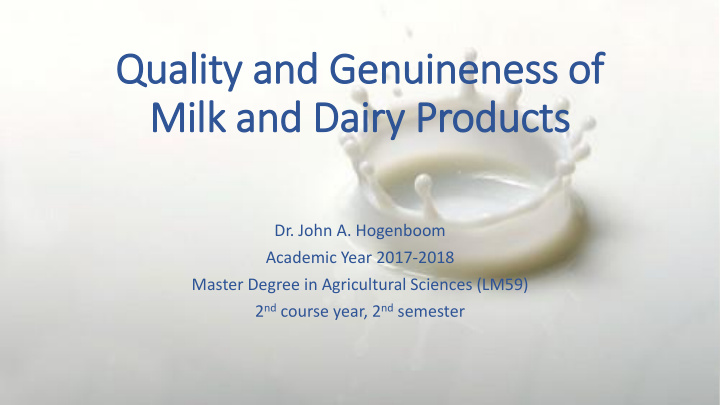



Quality and Genuineness of f Milk and Dairy Products Dr. John A. Hogenboom Academic Year 2017-2018 Master Degree in Agricultural Sciences (LM59) 2 nd course year, 2 nd semester
Introduction Quality: measure which expresses how excellent or good something is For food: Nutritional value / healthiness Digestibility / low damage due to processing Safety / absence of undesired, harmful or toxic components Genuineness: the fact of being authentic, not adulterated / possessing the claimed characteristics, qualities, or origin Food quality and genuineness must be demonstrated → LABORATORY ANALYSES Food quality and genuineness must be communicated to consumers → LABELLING
Course Program • Overview • EU regulations on labelling and quality control • Tools suitable to control chemical, biochemical and technological quality and genuineness of milk and derived food products • Frauds in the dairy field and methods to detect and/or prevent them • Product characterization on the basis of chemical and biochemical parameters Class lessons will be integrated with laboratory visits and hands-on practice exercises
Course Program • Legal aspects of food labelling and quality control • Regulation (EU) 1169/2011: on the provision of food information to consumers • Regulation (EC) 510/2006: on the protection of geographical indications and designations of origin for agricultural products and foodstuffs • Regulation (EU) 1151/2012: on quality schemes for agrcultural products and foodstuffs
Course Program • Basic chemical determinations for dairy products • Proteins and nitrogen fractions (NCN; NPN, etc.) (Kjeldahl; Dumas) • Fat (Röse-Gottlieb; Gerber) • Lactose/reducing sugars (HPLC) • Minerals (Ca, salt …) • pH and acidity • Density • Rapid methods based on I.R. spectrometry : the Milkoscan
Course Program • Advanced chemical determinations for dairy products • Fatty acids (saturated/unsaturated) (GC) • Heat damage (Maillard reactions products) • Lactic acid/organic acids • Conjugated linoleic acid (CLA) • Heavy metals • Residues • …..
Course Program • Most frequent adulterations of dairy products • sale of reconstituted milk powder as fresh milk • “fresh” milk from previously pasteurized milk • addition of margarine to cheese to reach legal fat content • Detection of reconstituted milk powder in Mozzarella cheese • Detection of cow’s milk in buffalo Mozzarella cheese and in ewe’s or goat’s milk cheese • …..
Course Program • Product characterisation • Evaluation of cheese typicalness (FAA, IEC) • Verification of ripening duration (pyro-glutamyl- γ 3-casein) • Verification of milk heat treatment (ALP) • Detection of rind addition to grated cheese (peptides) • Correct use of lysozyme in G.P. processing • …..
Final examination • Study material • Students’ notes • Slides of the lessons • Internet sites indicated during lessons • Examination • Examination will be oral • Based on student’s knowledge of the subject’s matter NOT on its knowledge of the English language
Lesson schedule • Thursday 1:30-4:30 p.m., in classroom C06 (Via Mangiagalli, 25) • For who is interested: • If lesson schedule is a problem for you: send an e-mail to john.hogenboom@unimi.it or phone at 02 503 16663 • state the days/hours which would best fit into your study plan • Schedule will then be planned on the basis of student’s possibilities
Recommend
More recommend